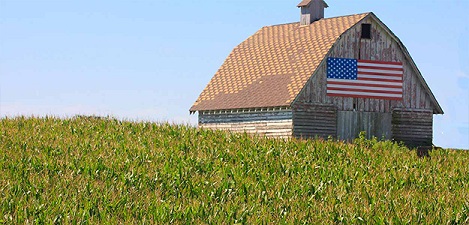
U.S. conservation programs help bring environmental sustainability to farms, ranches and forest land to improve conservation and environmental stewardship. Farmers who produce major crops on highly erodible land without a conservation plan, or convert wetlands to agricultural use, lose federal benefits under a wide range of USDA programs.
Background: Beginning in the 1980s, many agricultural policymakers felt that too much highly erodible land, and too many wetlands, were being converted to crop production. Congress and the public felt that farm programs created artificial incentives to put fragile lands into production, potentially leading to undesirable effects: environmental degradation, the use of public money in a manner inconsistent with environmental goals, and agricultural production in excess of market needs. As a result, in the 1985 farm bill, Congress enacted “conservation compliance,” which denies farm program benefits to producers who cultivate highly erodible land without a conservation plan or convert wetlands. Because the overwhelming majority of acreage in major field crops is enrolled in farm programs, conservation compliance is effectively binding for most of these farmers since they do not wish to risk the loss of benefits.
Sodbuster: The highly erodible land regulations are often referred to as “sodbuster” rules, and those governing wetlands as “swampbuster” rules. The sodbuster provisions require implementation of certain approved conservation practices, as a condition of eligibility for benefits, on highly erodible land. Under certain circumstances, penalties may be graduated rather than a complete loss of all benefits.
In combination with other policies, the sodbuster regulations have materially reduced average soil erosion rates. For example, in 1982 – before sodbuster – the United States lost more than three billion tons of soil to wind and water erosion. By 2007, this loss had been cut almost in half.
Swampbuster: “Swampbuster” regulations are based on a similar approach. Producers who plant specified crops on wetlands or who convert wetlands for agricultural production (even if no production occurs) are ineligible for farm program benefits. Wetlands are defined in terms of the presence of hydric soils, hydrophytic vegetation and other factors. As with sodbuster, there are certain exemptions from the ban on conversion, including wetlands that were converted to cropland before the swampbuster law was enacted. The swampbuster policies appear to have been effective, in that the number of wetlands converted to cropland was reduced.
Congress significantly expanded conservation compliance in the Agricultural Act of 2014 (2014 farm bill) by including federal crop insurance premium subsidies in the list of benefits that could be lost if a producer is out of compliance with the sodbuster (see above) and swampbuster provisions, depending on the date wetlands were converted and the number of acres involved. The 2014 farm bill also renewed an existing but previously unused program called “sodsaver,” whereby farmers who plant crops on native sod in six specified states will receive lower crop insurance premium subsidies in the first four years of planting.
Administration and Enforcement: Two different USDA agencies have important roles in the sodbuster and swampbuster policies. The Natural Resources Conservation Service (NRCS) makes technical determinations, such as whether a particular tract of land is highly erodible, or whether any exemptions apply to a wetland that a farmer wants to convert. The Farm Service Agency (FSA) handles actual enforcement, including penalties.
The sodbuster and swampbuster provisions apply to a wide range of USDA benefits. Among these benefits – which producers lose if they violate conservation compliance – are income support payments, price support loans, disaster payments, farm operating and ownership loans, conservation benefits and now crop insurance subsidies.
Statutory Authority: 16 U.S.C. 3801, 3812 and 3822(h). Read more.


